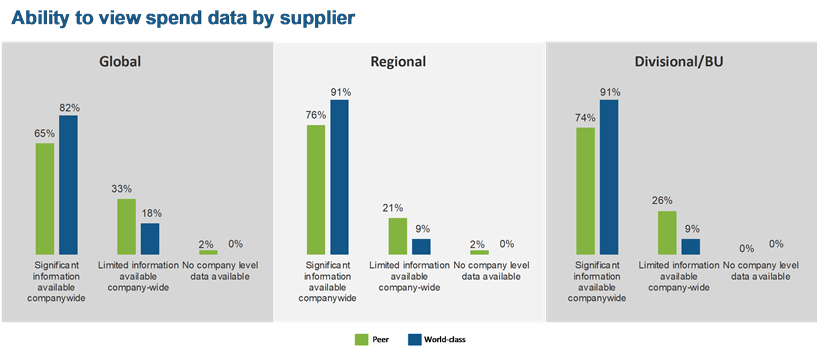- Blog
- Make Procurement Better through Spend Visibility and Advanced Analytics
Make Procurement Better through Spend Visibility and Advanced Analytics
Laura Gibbons,
Research Director, Procurement Executive Advisory and
Amy Fong,
Associate Principal The Hackett Group
Advances in analytics and information management open up a whole new world of decision-making capabilities for procurement organisations.
Improving procurement's performance is dependent on its ability to maximise the value of digital tools. And while there are many ways for technology to improve the various aspects of purchasing, data and analytics are one area that can truly unlock new abilities.
Importance of Advanced Analytics in Procurement
Procurement analytics play an important role in managing not only procurement functions, but the entire organization as well. As you start to automate more of your procurement processes, you’ll inevitably begin to create more data. As this data accumulates, it builds a wealth of information that is just waiting to be delved into. This information can offer market intelligence, spend visibility, risk mitigation, price optimization, and even help with vendor selection.
See a Strategic Future with Procurement Analytics
What exactly is procurement data analytics? At its core, it’s the process of collecting all your procurement data and using it to make predictions, develop insights, and make plans to strengthen your procurement processes.
Traditionally, procurement data has existed in silos, kept isolated by different technology applications and structures. Difficult to extract and keep updated, data was used principally in structured reporting, such as supplier KPIs or infrequent spend analytics exercises. Plus, delivering informed options for purchasing, managing risk, and spotting areas of opportunity requires staff with the ability to conduct sophisticated analysis using data from internal and external sources – an ability which didn’t always exist in the procurement function.
Advances in technology now make it possible to harness data on a global scale and today are considered essential in the procurement function (Fig. 1). New tools for data aggregation and data mining can provide insight about the past, helping to deliver cost reduction and cost-avoidance savings by anticipating future behavior. Procurement staff can leverage advanced business intelligence (BI) tools to identify new opportunities and track savings opportunities

Fig. 1 - Source: The Hackett Group, 2018 Benchmark Data
Solid Spend Strategy = Smarter Sourcing and Decisions
Procurement organisations understand that providing superior support to the business requires looking to the future via predictive and prescriptive analytics. It must move its analytics capabilities forward by simplifying, improving, and integrating data and information management. The variety of analytics it offers can be expanded both through adopting new tools and changing the way data is stored, used, and presented.
A common strategy for top performing procurement groups is to adopt online dashboards, accessible by team members and fully customisable for each user. For example, a CPO can login and instantly access global spend reports, including high level performance indicators for the last month, 24 hours a day. Or, a regional sourcing manager can locate and analyse sourcing trends for a specific category over a two-year period, perhaps leading to greater spend under influence or reduced supply risk.
Shine a Light on Maverick Spend
Maverick spend has consistently been a troublesome area for procurement organisations because of the difficulty in measuring it, as well as the difficult in identifying the cause of it. With a detailed spend visibility process, organisations can now track and quantify poor spend habits. Figure two below illustrates that most organisations (peer group) see compliance levels in the 60-75% range for most categories. Those organisations that lead in experience and compliance (E&C Leaders) have more compliance processes.
Across the board, organisations struggle with maverick spend, but there are ways to leverage advanced analytics and data to drive compliance to approved suppliers and reduce lost savings, including:
-
Centralising the contract management process and providing real-time access to preferred suppliers’ contract metadata at the time of purchasing
-
Ensuring a formal enterprise-wide master data strategy and contract management processes that provide visibility to transactional information needed for compliance monitoring
-
Reviewing non-PO transactional activity regularly for non-compliance to the preferred supplier policy
-
Setting targets for compliance and lost savings by the business to encourage adoption
Procurement Analytics Examples
Here are a few different ways you can use procurement analytics:
-
Adopt a data-driven approach to selecting suppliers
-
Compare real-time pricing and availability from suppliers
-
Get a total view of all spend
-
Analyze purchasing data to support a comprehensive procurement strategy
Where to Start?
The benefits of spend visibility do not come without their own rigorous process. Best-in-class organisations start by understanding how to capture and combine all existing spend data and then filling the gaps for spend data not being captured. Laying the foundation of a strong data and analytics strategy is the most critical component in achieving spend visibility –ultimately providing flexibility in the future to harness data in new and more strategic ways.
You might also like…
https://www.basware.com/en-en/resources/how-to-maximise-value-from-spend-data/
https://www.basware.com/en-en/blog/january-2020/digitization-opens-the-door-for-big-data-in-procur/
Learn More
Want to learn more about the benefits of data and technology for spend visibility? Read our white paper “3 Disruptive Trends for Finance and Procurement” and as always, contact us with any questions.
Related
-
By Basware RepresentativeThe route to logistics software harmony for finance, AP and procurement
-
By Katarzyna FonteynA Reflection on the State of Procurement
-
By Katarzyna FonteynHow to create procurement visibility from day 1
-
By Basware RepresentativeDon’t Delay Digital Procurement & Finance Investments
-
By Ann StrömbergNordic Leaders Circle focused on procurement development
-
By Katie ColbourneProcure-to-Pay Trends Predictions and Advancements for 2022 and Beyond
-
By Basware RepresentativeBasware to Help Expand e-Invoicing with the Business Payment Coalition
-
By Ann StrömbergProcurement Collaboration, Resilience, Technology, and Sustainability
